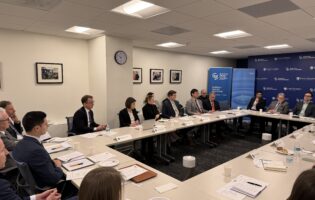Integration 2.0: Local Government-NGO Cooperation
On April 16, 2010, the American Institute for Contemporary Studies (AGI) hosted a discussion on “Integration 2.0: Local Government-NGO Cooperation and Transformation of Citizenship in the United States and Germany” as part of its Society, Culture & Politics Program. Dr. Scott Stock Gissendanner, DAAD/AGI fellow, presented his research on the integration of immigrant groups in both the United States and Germany, highlighting ways in which immigrant groups work together with local and subnational governments toward increasing the production of collective consumption goods and promoting the integration of immigrants as productive members of society.
Dr. Stock Gissendanner highlighted the challenges of increasing immigration and the politics and conflicts of integration within the global context before introducing the core question of his research on non-government organization (NGO) and local government collaboration, which he identifies as “Integration 2.0.” In describing this new stage of integration, the typology of governance relationships were further discussed and supported with German and American case study examples.
In comparing Germany and the U.S., it is apparent that both countries have experienced an overall surge in immigration in the last decade, with an accompanying increase in diversity. These changes intensify the challenge of integrating new immigrants of low socioeconomic status, ethnic difference, and religious difference. While these challenges are faced within the context of global migration flows at the regional and national level, the politics and conflicts of integration are not evenly distributed. These challenges and the shifts in immigration are instead geographically concentrated, meaning that while the impact of increased immigration is often seen at the national policy level, it is directly felt and addressed at the local and regional level. Therefore, subnational and local governments bear the largest responsibility for addressing issues of distributing collective consumption goods (such as healthcare, schooling, and police) to citizens and immigrants. As integration becomes more closely linked with the production of these goods and the questions of who gets what, when, and how, integration can be seen as having reached a new stage.
This shift toward “Integration 2.0” is characterized by the increased cooperation between NGOs and subnational government officials. Immigrant NGOs have a strong presence in both the U.S. and Germany – in the DC metro area alone, 533 NGOs serve immigrant clients while in Germany, as of 1995, there were approximately 3,200 Turkish organizations. The typology of government and NGO relationships can best be understood on a continuum, spanning from objectification, in which the government holds all the power, to collaboration, in which the government and an NGO are equal partners focused on joint strategic action. In between fall eight other points of typological differentiation, including coproduction, in which NGOs volunteer and assist the government in providing a service; contracting, in which NGOs are paid for their services; and complementarity, in which NGOs offer their specialized knowledge of access to client groups. According to this model, as the government moves from a model of objectification to one of collaboration and the top-down model of governance decreases, formalized common decision-making, acceptance of institutional pluralism, and symmetrical power relationships are all expected to increase. For the government, increased partnership with NGOs helps to efficiently meet the government’s needs to build steering capacity as it intervenes in a complex system; NGOs simultaneously contribute their resources in knowledge of what clients want and how to effectively distribute these resources. This model of integration is intended to capture the fact that the question of citizenship acquisition in many localities today focuses not on the question of “who are you” but rather on the more pragmatic question of “what can you do for us?”
This shift in integration and how immigrant NGOs and the government interact is evident in three case study examples: two in the D.C. metro area, and one in Berlin.
The first case is that of the Muslim Community Center Mosque and Medical Clinic and the Montgomery Cares Program, located in Montgomery County, Maryland. Based on a need for delivering primary healthcare to the uninsured (both Muslim and non-Muslim), the Muslim Community Center began operating a health clinic in its basement in 2003. In 2005, the county council began subsidizing the work of this and five similar clinics so as to expand primary health care provision to the county’s uninsured residents. By working together, the government is thus able to ensure that its citizens are healthy, and is able to effectively leverage private funds, while the Clinic is able to see more patients and deliver a broader range of services.
The second model focuses on day labor centers in Herndon, VA, and Langley Park, MD. The presence of day laborers in both of these areas brought tensions with members of the local communities. Searching for a solution in Langley Park in the early 1990s, the NGO CASA de Maryland began regulating the market on its own but later contracted with the county to receive a site for a center in which day laborers could gather of the streets and to also utilize the space for job training. By 2009, one-third of the funds supporting CASA’s day labor center came from public funds. In Herndon, the efforts at collaboration met different results when, after an NGO initiative gained county government support, the voters later shut down the plans for a day labor center in a 2005 referendum.
The third and final example of collaboration is that of the Turkish Federation in Berlin (TFB). Founded in 1991, the TFB has steadily shifted toward increased collaboration with the German government, but is still struggling to achieve successful cooperation. In working on local projects, the TFB now relies on 99 percent of public funds for its budget. A problem of NGO/government cooperation can be illustrated with this case: The conflict that emerges when governments want NGOs to function as givers of input into its own policy making processes (serving merely as “informants”) without giving them genuine influence over the outcomes of policymaking.
The success of the Montgomery County Clinic and of CASA de Maryland in establishing collaboration between immigrant NGOs and local governance contrasts the failure of collaborative efforts in Herndon, and ‘informing’ level of cooperation between the TFB and local governance in Berlin. The differences in the outcomes of these three case studies can likely be attributed, in part, to differences in the kind of good being produced, the resources available, and the preexisting institutional environment, particularly the strength of cooperation between the local government and current and former immigrant NGOs.
Hypothetically, the cooperation of immigrant NGOs and local governance functions cyclically. As government officials open participatory windows to immigrant NGOs, resources are mobilized for these organizations, and NGO immigrant clientele then have the opportunity to mobilize these resources into productive societal inputs. If such opportunities and available resources are utilized to the fullest potential of production, then government officials are likely to be open to a broader range of future cooperation with such organizations. The differing outcomes in the above three cases also suggest that historical and cultural differences of cooperation impact both state and immigrant organizations’ interests and interactions within this cycle. For example, it is unlikely that immigrant NGOs will attain the same influence in Germany that they have in the U.S., based largely on the preexisting institutional interactions between NGOs and local governance. However, as illustrated in the continuum of government-NGO interaction, both the U.S. and Germany are progressing at different rates toward increased government-NGO collaboration. Where exactly along this continuum immigrant NGOs and the government will settle in either of these countries is uncertain, but as immigration and diversity continue to increase in both Germany and the U.S., forms of collaboration between immigrant NGOs and subnational governments can emerge that are beneficial for all involved. Under optimal conditions, government officials, long-time residents, and new immigrants can learn to produce collective goods more efficiently together than they could alone.







